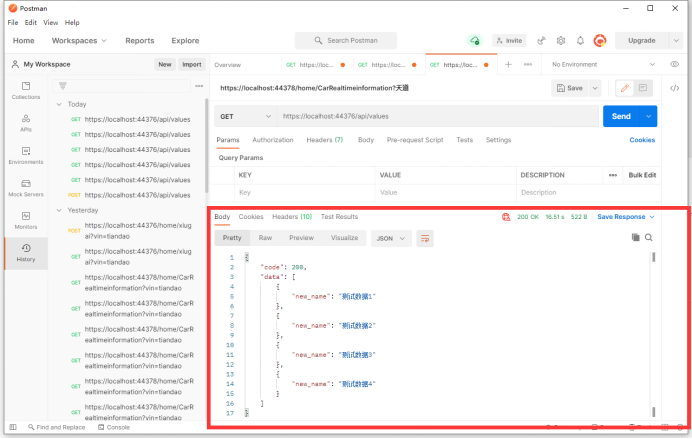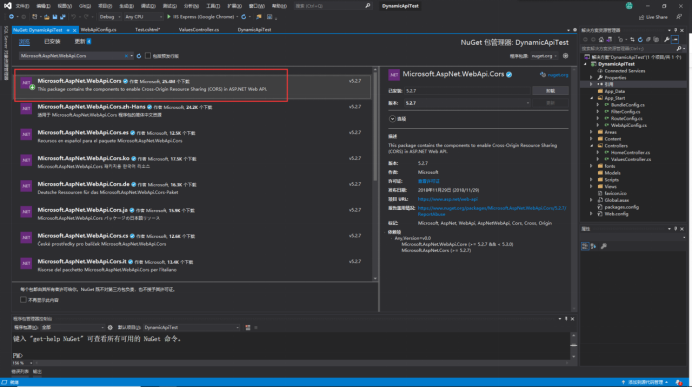简单版本
using Microsoft.Ajax.Utilities;
using Microsoft.Xrm.Sdk;
using Microsoft.Xrm.Sdk.Client;
using Microsoft.Xrm.Sdk.Query;
using System;
using System.Collections.Generic;
using System.Linq;
using System.Net;
using System.Net.Http;
using System.ServiceModel.Description;
using System.Web.Http;
using System.Text;
namespace DynamicApiTest.Controllers
{
public class ValuesController : ApiController
{
Uri orgServiceUri = new Uri("http://10.20.100.150:7777/Index/XRMServices/2011/Organization.svc");//组织服务地址
ClientCredentials clientCredentials = new ClientCredentials();
//连接dynamic的账号和密码
public void run()
{
clientCredentials.Windows.ClientCredential = new NetworkCredential("lanhai", "P@ssw0rd", "LANHAI");
}
// GET api/values
public EntityCollection Get()
{
run();
using (OrganizationServiceProxy sev = new OrganizationServiceProxy(orgServiceUri, null, clientCredentials, null))
{
QueryExpression q = new QueryExpression("new_student");
q.ColumnSet = new ColumnSet(true);
EntityCollection ee = sev.RetrieveMultiple(q);
StringBuilder sr = new StringBuilder();
return ee;
}
}
// GET api/values/5
public string Get(int id)
{
return "value";
}
// POST api/values
public void Post([FromBody] string value)
{
}
// PUT api/values/5
public void Put(int id, [FromBody] string value)
{
}
// DELETE api/values/5
public void Delete(int id)
{
}
}
}
前端接收
<h2>Test</h2>
<script src="~/Scripts/jquery-3.4.1.js"></script>
<div>
<ul id="entityname">
</ul>
</div>
<script>
$.ajax({
url: "/api/values",
type: "get",
dataType: "json",
contentType: "application/json",
success: function (data) {
console.log(data);
}, error: function (data) {
console.log("lose");
}
})
</script>
将服务地址和登录账号、密码写入配置文件中

单独写一个servicehelper类来访问dynamic数据
using Microsoft.Xrm.Sdk;
using Microsoft.Xrm.Sdk.Client;
using Microsoft.Xrm.Sdk.Discovery;
using System;
using System.Collections.Generic;
using System.Configuration;
using System.Linq;
using System.Web;
namespace DynamicApiTest.Models
{
public class ServiceHelper
{
private static OrganizationServiceProxy organizationProxy { get; set; }
public static OrganizationServiceProxy InitOrganizationProxy()
{
string _discoveryServiceAddress = ConfigurationManager.AppSettings["DiscoveryServiceAddress"];//获取组织服务地址
IServiceManagement<IDiscoveryService> serviceManagement = ServiceConfigurationFactory.CreateManagement<IDiscoveryService>(new Uri(_discoveryServiceAddress));
AuthenticationProviderType endpointType = serviceManagement.AuthenticationType;
AuthenticationCredentials authCredentials = GetCredentials(endpointType);
string organizationUri = ConfigurationManager.AppSettings["DiscoveryServiceAddress"];
if (!String.IsNullOrWhiteSpace(organizationUri))
{
IServiceManagement<IOrganizationService> orgServiceManagement = ServiceConfigurationFactory.CreateManagement<IOrganizationService>(new Uri(organizationUri));
AuthenticationCredentials credentials = GetCredentials(endpointType);
return GetProxy<IOrganizationService, OrganizationServiceProxy>(orgServiceManagement, credentials);
}
else
throw new Exception("未连接服务!");
}
private static AuthenticationCredentials GetCredentials(AuthenticationProviderType endpointType)
{
string _userName = ConfigurationManager.AppSettings["UserName"];
string _password = ConfigurationManager.AppSettings["Password"];
AuthenticationCredentials authCredentials = new AuthenticationCredentials();
switch (endpointType)
{
case AuthenticationProviderType.ActiveDirectory:
authCredentials.ClientCredentials.Windows.ClientCredential = new System.Net.NetworkCredential(_userName, _password);
break;
case AuthenticationProviderType.Federation:
case AuthenticationProviderType.OnlineFederation:
authCredentials.ClientCredentials.UserName.UserName = _userName;
authCredentials.ClientCredentials.UserName.Password = _password;
break;
default:
break;
}
return authCredentials;
}
private static TProxy GetProxy<TService, TProxy>(IServiceManagement<TService> serviceManagement, AuthenticationCredentials authCredentials)
where TService : class
where TProxy : ServiceProxy<TService>
{
Type classType = typeof(TProxy);
if (serviceManagement.AuthenticationType != AuthenticationProviderType.ActiveDirectory)
{
AuthenticationCredentials tokenCredentials = serviceManagement.Authenticate(authCredentials);
return (TProxy)classType
.GetConstructor(new Type[] { typeof(IServiceManagement<TService>), typeof(SecurityTokenResponse) })
.Invoke(new object[] { serviceManagement, tokenCredentials.SecurityTokenResponse });
}
return (TProxy)classType
.GetConstructor(new Type[] { typeof(IServiceManagement<TService>), typeof(System.ServiceModel.Description.ClientCredentials) })
.Invoke(new object[] { serviceManagement, authCredentials.ClientCredentials });
}
}
}
ResultDTD 类
public class ResultDTD
{
public int code { get; set; }
public object data { get; set; }
}
在api中访问dynamic数据,并返回一个json字符串
public IHttpActionResult Get()
{
using (OrganizationServiceProxy sev = ServiceHelper.InitOrganizationProxy())
{
//查询对应实体信息,返回一个json字符串
string xml = $@"<fetch version='1.0' output-format='xml-platform' mapping='logical' distinct='false'>
<entity name='tx_testentity_1'>
<attribute name='tx_testentity_1id' />
<attribute name='tx_name' />
<attribute name='createdon' />
<order attribute='tx_name' descending='false' />
</entity>
</fetch>";
var fetch = new FetchExpression(xml);
EntityCollection response = sev.RetrieveMultiple(fetch);//获取实体信息
ResultDTD result = new ResultDTD();//返回的数据类
result.code = 200;//状态码
if (response.Entities.Count > 0)
{
result.data = response.Entities.Select(x => new new_testentiyt_1//根据查询到的数据封装的一个类
{
new_name = x.GetAttributeValue<string>("tx_name")//fetch查询到的数据
});
}
//将json字符串转化为list集合
//string value = JsonConvert.SerializeObject(result.data);
//ls = JsonConvert.DeserializeObject<List<类名称>>(value);
return Json(result);
}
}
//返回结果
跨域设置





origins:允许访问的域名,多个域名以逗号分隔。使用“*”全部允许。
headers:配置所支持的资源,使用“*”全部允许,使用null或“”不允许。
methods:配置支持的请求方法,使用“*”全部允许,使用null或“”不允许。